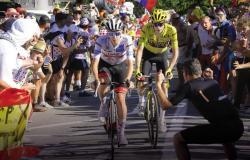The Le Muse cultural associationLaboratory of Arts and Letters” from Reggio Calabria is fresh from his first appointment in Sicily. Cultural exchanges that see real in-depth analyzes aimed at understanding the Italian historical and artistic heritage and/or museums that maintain the identity and history of the places where they are located. The members led by the tireless president and the members of the board of directors were out this weekend for 4 different events which in two days saw the well-known association present in Trabia, Bagheria, Palermo and Piana degli Albanesi.
We thought he stated Giuseppe Livoti to visit new and unexpected places, expanding our network of collaborations and knowledge with which to create a Sicily-Calabria network on the occasion of the twenty-fifth anniversary in September, thus bringing various characters who animate the cultural dialogue outside our land. In Trabia it was an opportunity to visit Castello Lanza which lies on the place where General Aausman Ben Muhammad and 600 men from the province of Ifriqyia built the At Tarbiq fortress in order to lay siege to the city of Termini Imerese (827 AD) . The square footprint of 50 x 50 m remained unchanged for the following 12 centuries and influenced the history of the area surrounding it to such an extent that it was borrowed by the founders of the current settlement – the powerful Branciforte-Lanza – when it was granted to them the licentia populandi (17th century). And yet an in-depth look at the Villa Palagonia in Bagheria, one of the best known and most visited monuments in Sicily. Superb and eccentric villa which, already in the eighteenth century, was visited by illustrious travellers, who considered it the “most original place that exists in the world and famous throughout Europe”. Its construction began in 1715 at the behest of Don Ferdinando Gravina and Crujllas, 4th prince of Palagonia, peer of the kingdom, knight of the Golden Fleece, prestigious honor of the kings of Spain.
The Dominican friar Tommaso Maria Napoli, assistant architect of the Senate of Palermo with the qualification of “military engineer”, was commissioned to design this holiday residence. In 1737, with the succession of Ignazio Sebastiano Gravina, heir of his father Francesco Ferdinando, work began on the construction of the lower bodies surrounding the villa. And again Le Muse were received by the Pro Loco of Piana degli Albanesi for an in-depth analysis of the most important and well-known center of the Albanians in Sicily, as well as the largest Arbëresh settlement, where the most populous Albanian community in Italy has historically resided for centuries. Until 1941 called Piana dei Greci for the Greek-Byzantine rite professed by its inhabitants, it is the episcopal seat of the Eparchy of Piana degli Albanesi, a constituency of the Italian-Albanian Church, whose jurisdiction extends over all the insular churches of the Eastern rite. Over the centuries it has been counted among the major active and influential centers of the Italian-Albanians, protecting and cultivating the historical memory of the ancient motherland. In addition to being the socio-cultural, religious and political fulcrum of the Arbëreshe communities on the island, it has kept its ethnic peculiarities almost intact, such as the Albanian language, the Greek-Catholic rite and the characteristic original customs. In the modern age it played a significant role in the revolutionary and Risorgimento movements relating to the national unity of Italy, the regional movements of the Sicilian Workers’ Fasci and the question of the Albanian national “Rilindja” in the struggle for liberation from Turkish-Ottoman domination . Between 1944 and 1945, which lasted fifty days, Piana degli Albanesi became an independent People’s Republic. It is also sadly known for the Portella della Ginestra massacre (1947).
The highlight of this trip was the meeting at the Piraino House Museum, a place, a point of conjunction between Eclecticism and Liberty between clothes and accessories, and a thousand works of art and decorative art, archaeological finds and design objects, collected in over half a century. Professor Raffaello Piraino, collector, artist and teacher of History of Costume and Scenography at the Academy of Fine Arts, welcoming and greeting “Le Muse”, immediately told how this passion was born which saw him seeking the collaboration of noble families of Palermo going to visit attics and warehouses and finding a lot of material. What emerges is a rich collection of mine comparable to the one that is today housed in Palazzo Pitti in Florence where all of Franca Florio’s clothes are also preserved. My hope is to find a location in a dedicated structure, perhaps in a larger historic building since the current one is my home, my meeting place, where I am surrounded by so much memory. The heart of the collection collects material dating between the eighteenth and twentieth centuries, mainly of Sicilian origin with various focuses to which from time to time Piraino dedicates small thematic temporary exhibitions. A journey through ceramics, fans, clothes, works of pictorial and mosaic art, engravings and graphics, applied arts and furniture together with the corpus of photographs, magazines and publications that are part of the private archive. As a cultured collector-humanist with a professional background, Professor Raffaello Piraino spoke about his collaborations and friendships with Leonardo Sciascia, Renato Guttuso, Sebastian Matta, Jannis Ritsos, Andrea Volo, Ferdinando Scianna, emotionally anchored to the past of the immediate post-war period and constantly projected towards the future and towards the youngest. The Muse members were able to savor the social life of the upper middle class, surrounded by the pomp and elegance of the past, passing through the elegant rooms of the building and focusing on a “dress made for Donna Franca Florio”, which is said to have never has ever worn it and given it to her wardrobe. The meeting ended with a communion of intent and the exchange of the Le Muse pennant while president Livoti snatched the prof. Piraino a promise, to see him in Reggio Calabria on the occasion of the 25 years of activity of the well-known Calabrian association. Another great Muse event is expected for next Sunday which will see the resumption of the historic “Nocturnes” with the awarding of the prize to the journalist Carmen Lasorella and many new things.






